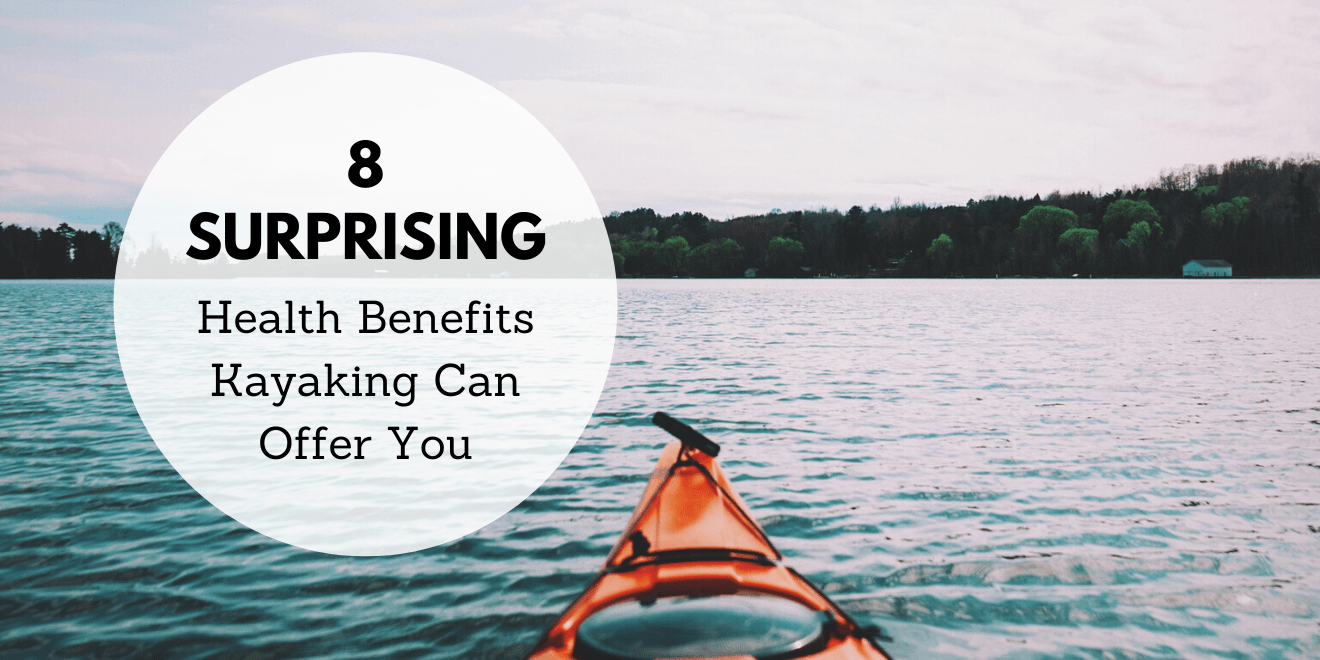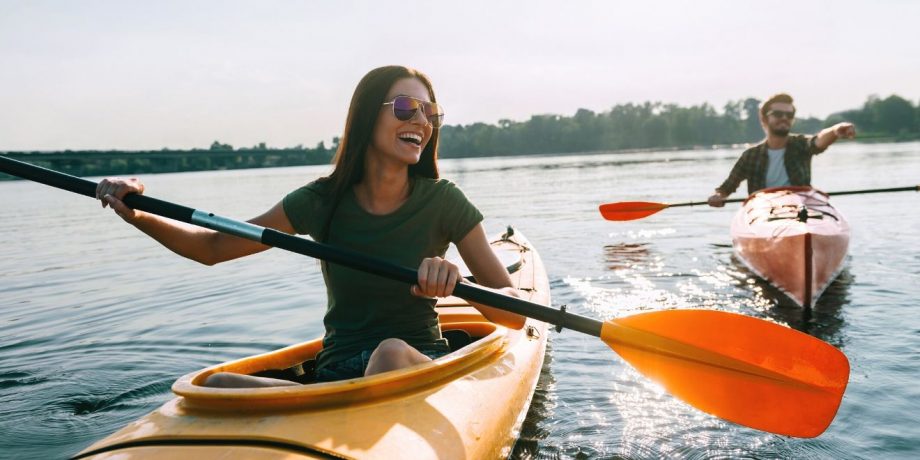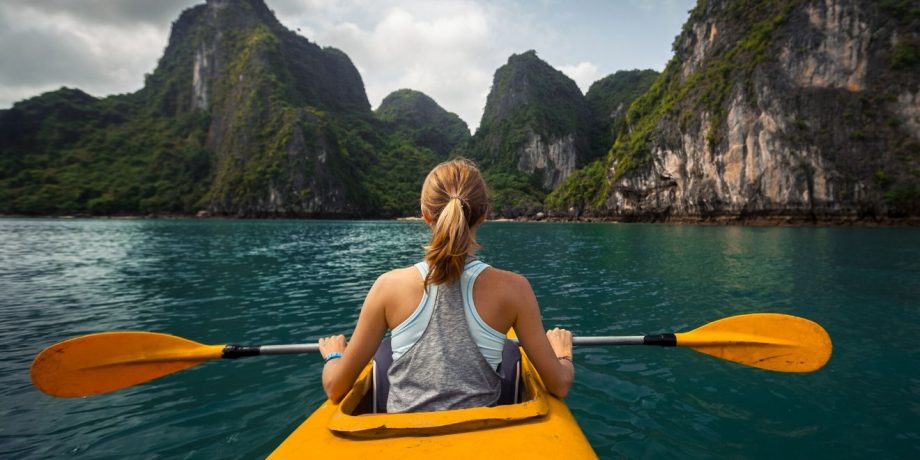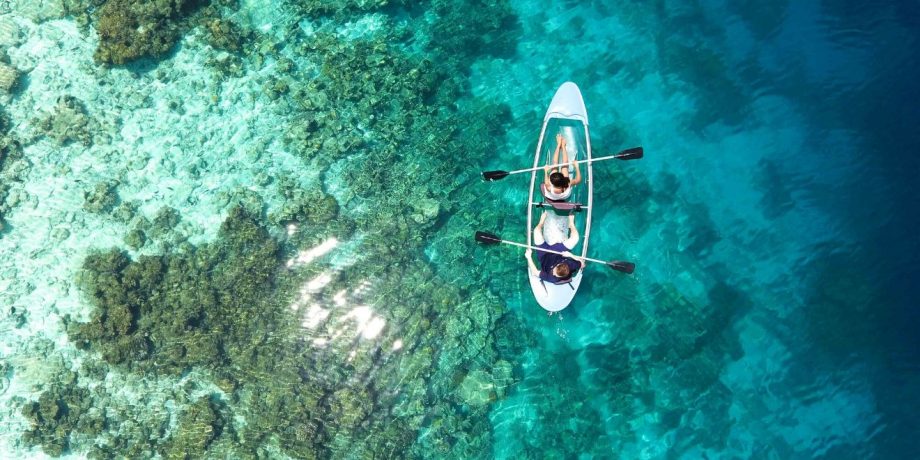8 Surprising Health Benefits Kayaking Can Offer You

Summer is just around the corner and you want to look and feel your absolute best.
Gyms are great tools to stay in shape but it’s sunny out and you want to get outside! Truth be told there are lots of different outdoor activities where you can experience the great outdoors and stay in shape.
In my honest opinion, few of them come close to the meditative benefits of paddling a kayak on calm water.
To me, kayaking is one of the purest ways of being surrounded by nature. Not only are you floating in the middle of the water immersed with all the possibilities but it’s also a great way to experience things you could not of on land. Often times I am greeted by a friendly seal or I see an eagle catch a fish right in front of me!

Believe it or not, kayaking actually has a lot of proven health benefits that can impact your body in a positive way. Here are a few that I have researched and found from personal experience.
When kayaking at a pace of 4-5 miles per hour consistently you can burn more calories then if you were out hiking at a moderate pace. Kayaking at this pace burns approximately 400 calories per hour while hiking burns 387 calories per hour. The key here is emphasizing a consistent pace, if you are just casually paddling and stopping every few minutes you will burn fewer calories. What I often do is actually paddle against the tide when the tide is coming in.
A perfect place to do this is in a river or cove that feeds out into the ocean. When you have a place to be and are forced to keep moving you will burn a considerable amount of calories all the while staying active and getting some of the fresh air mother nature provides.
While there is no substitute for working out and doing strength training, kayaking can help build up some of those muscles in these areas. Specific muscle groups that kayaking can target include the Lats, Rhomboids, and Latissimus Dorsi in the back, pectoral muscles in the chest. In terms of arms and shoulders, kayaking helps work on the Biceps, Brachialis, Triceps. Trapezius, the Deltoids (rear, lateral and anterior) as well as the Forearms (Flexor Carpi Radialis, Pronator Teres, Palamaris Longis, and the Flexor Carpiulnarls). After consistently kayaking for much of the spring and summer you will see your strength improve in these muscle groups.
Again the key here is consistency.

Often times athletes and weightlifters coming straight out of an injury try to find low strain activities to reactivate the muscles but also want low stress on the muscle groups. Paddling a kayak allows you to engage those muscles as much or as little as you want. This makes it a perfect recovery activity. When going out paddling, make sure that the weather is calm out and the water is still. If you have to vigorously paddle against the tide or wind then it defeats the point of muscle recovery.
Note to Reader: If you're still a beginner, and you're searching for your perfect kayak, Globo Surf has some great tips on how to choose a kayak that will be very helpful.
We already mentioned above that kayaking can burn around 400 calories per hour paddling at a 4 - 5 miles per hour pace. The calories burned will be more or less dependant on how much time and vigor you put into your paddling. It is also dependant on how much the person weights. Harvard Health reports that a 125 lb person can burn as much as 150 calories, a 155 lb person can burn as many as 186 calories per hour and a 185 lb person can burn as much as 222 calories per hour.
From personal experience, I can tell you that when I’m on the water all of my troubles and worries go away.
Perhaps it’s because I’m in the great outdoors getting much-needed vitamin D on my skin, or perhaps the simple act of floating on the water can provide huge meditative benefits to a clear mind. Doing an activity that you love all the while in a relaxing environment can greatly decrease your stress levels.
Many people used the outdoors as a tool for meditation because it gives them a wide array of benefits. Some of those being increased energy, improved memory, decrease in anxiety and stress, more awareness, and sharper focus. All of these can be used as tools to produce a better routine for yourself.

Stress is one of the biggest symptoms for a lack of sleep. A simple cure for that is a clear mind and some physical exercise. Luckily regular kayaking checks off both boxes. The meditative properties of being on the water help clear your mind from whatever was bothering you that day. Its also proven that at least 30 minutes of moderate exercise can improve the quality of sleep in many individuals, which is great because normally kayaking takes at least an hour.
I recently read an article that stated that Saltwater actually has many different benefits useful for people with different conditions such as skin conditions and wounds, Hay Fever, and sinus issues (Me!) as well as being an effective tool in cold water therapy and meditation/ relaxation. While the article mostly states swimming in saltwater can be beneficial. As a kayaker, I know that you will have more than your fair share of ocean water on you at any one time, especially if you are sea kayaking. There is no doubt in my mind that when I am paddling in saltwater I experience many of the benefits that are stated in the article. I personally like to use salt water kayaking as a tool when I get hay fever in late March/ early April.

I can hear your exclamation now in my head as I am writing this, what?? Don’t you just sit most of the time, therefore, making your legs dormant and relatively useless in the endeavor? This is partially true but what you don’t think of is you are actually using your legs/ abdomen as a way to balance the kayak. You are using your lower body to counter the actions done by your upper body paddling to ensure you don’t get out of balance. It’s this subtle movement over time that can actually strengthen your leg muscles such as your gluteus maximus and your gluteus medius. You will particularly feel it if you are on a long kayaking trip, paddling at a decent pace.
These are just the tip of the iceberg when it comes to the health benefits you can experience while kayaking. I personally really like to use it as a tool to refresh and clear my mind after a string of long workdays. Why do you like to kayak?
Derek is a water enthusiast from Vancouver British Columbia who loves all things paddle boarding and kayaking. When he’s not out and about paddling he can be found working on his blog Floating Authority.
Gyms are great tools to stay in shape but it’s sunny out and you want to get outside! Truth be told there are lots of different outdoor activities where you can experience the great outdoors and stay in shape.
In my honest opinion, few of them come close to the meditative benefits of paddling a kayak on calm water.
To me, kayaking is one of the purest ways of being surrounded by nature. Not only are you floating in the middle of the water immersed with all the possibilities but it’s also a great way to experience things you could not of on land. Often times I am greeted by a friendly seal or I see an eagle catch a fish right in front of me!

Believe it or not, kayaking actually has a lot of proven health benefits that can impact your body in a positive way. Here are a few that I have researched and found from personal experience.
You Burn a Similar Amount of Calories Kayaking as if you were Hiking
When kayaking at a pace of 4-5 miles per hour consistently you can burn more calories then if you were out hiking at a moderate pace. Kayaking at this pace burns approximately 400 calories per hour while hiking burns 387 calories per hour. The key here is emphasizing a consistent pace, if you are just casually paddling and stopping every few minutes you will burn fewer calories. What I often do is actually paddle against the tide when the tide is coming in.
A perfect place to do this is in a river or cove that feeds out into the ocean. When you have a place to be and are forced to keep moving you will burn a considerable amount of calories all the while staying active and getting some of the fresh air mother nature provides.
Kayaking Increases Muscle Strength in your Arms, Back, Shoulders, and Chest.
While there is no substitute for working out and doing strength training, kayaking can help build up some of those muscles in these areas. Specific muscle groups that kayaking can target include the Lats, Rhomboids, and Latissimus Dorsi in the back, pectoral muscles in the chest. In terms of arms and shoulders, kayaking helps work on the Biceps, Brachialis, Triceps. Trapezius, the Deltoids (rear, lateral and anterior) as well as the Forearms (Flexor Carpi Radialis, Pronator Teres, Palamaris Longis, and the Flexor Carpiulnarls). After consistently kayaking for much of the spring and summer you will see your strength improve in these muscle groups.
Again the key here is consistency.

Kayaking Reduces Strain on your body making it a perfect low impact/recovery activity
Often times athletes and weightlifters coming straight out of an injury try to find low strain activities to reactivate the muscles but also want low stress on the muscle groups. Paddling a kayak allows you to engage those muscles as much or as little as you want. This makes it a perfect recovery activity. When going out paddling, make sure that the weather is calm out and the water is still. If you have to vigorously paddle against the tide or wind then it defeats the point of muscle recovery.
Note to Reader: If you're still a beginner, and you're searching for your perfect kayak, Globo Surf has some great tips on how to choose a kayak that will be very helpful.
Kayaking can help with your Weightloss
We already mentioned above that kayaking can burn around 400 calories per hour paddling at a 4 - 5 miles per hour pace. The calories burned will be more or less dependant on how much time and vigor you put into your paddling. It is also dependant on how much the person weights. Harvard Health reports that a 125 lb person can burn as much as 150 calories, a 155 lb person can burn as many as 186 calories per hour and a 185 lb person can burn as much as 222 calories per hour.
Kayaking Provides Immense Mental Benefits
From personal experience, I can tell you that when I’m on the water all of my troubles and worries go away.
Perhaps it’s because I’m in the great outdoors getting much-needed vitamin D on my skin, or perhaps the simple act of floating on the water can provide huge meditative benefits to a clear mind. Doing an activity that you love all the while in a relaxing environment can greatly decrease your stress levels.
Many people used the outdoors as a tool for meditation because it gives them a wide array of benefits. Some of those being increased energy, improved memory, decrease in anxiety and stress, more awareness, and sharper focus. All of these can be used as tools to produce a better routine for yourself.

Kayaking can Greatly Improve your Quality of Sleep
Stress is one of the biggest symptoms for a lack of sleep. A simple cure for that is a clear mind and some physical exercise. Luckily regular kayaking checks off both boxes. The meditative properties of being on the water help clear your mind from whatever was bothering you that day. Its also proven that at least 30 minutes of moderate exercise can improve the quality of sleep in many individuals, which is great because normally kayaking takes at least an hour.
Kayaking in Salt Water is Actually Good for You
I recently read an article that stated that Saltwater actually has many different benefits useful for people with different conditions such as skin conditions and wounds, Hay Fever, and sinus issues (Me!) as well as being an effective tool in cold water therapy and meditation/ relaxation. While the article mostly states swimming in saltwater can be beneficial. As a kayaker, I know that you will have more than your fair share of ocean water on you at any one time, especially if you are sea kayaking. There is no doubt in my mind that when I am paddling in saltwater I experience many of the benefits that are stated in the article. I personally like to use salt water kayaking as a tool when I get hay fever in late March/ early April.

Kayaking Increases Leg Strength
I can hear your exclamation now in my head as I am writing this, what?? Don’t you just sit most of the time, therefore, making your legs dormant and relatively useless in the endeavor? This is partially true but what you don’t think of is you are actually using your legs/ abdomen as a way to balance the kayak. You are using your lower body to counter the actions done by your upper body paddling to ensure you don’t get out of balance. It’s this subtle movement over time that can actually strengthen your leg muscles such as your gluteus maximus and your gluteus medius. You will particularly feel it if you are on a long kayaking trip, paddling at a decent pace.
These are just the tip of the iceberg when it comes to the health benefits you can experience while kayaking. I personally really like to use it as a tool to refresh and clear my mind after a string of long workdays. Why do you like to kayak?
Author Bio
Derek is a water enthusiast from Vancouver British Columbia who loves all things paddle boarding and kayaking. When he’s not out and about paddling he can be found working on his blog Floating Authority.




































































































